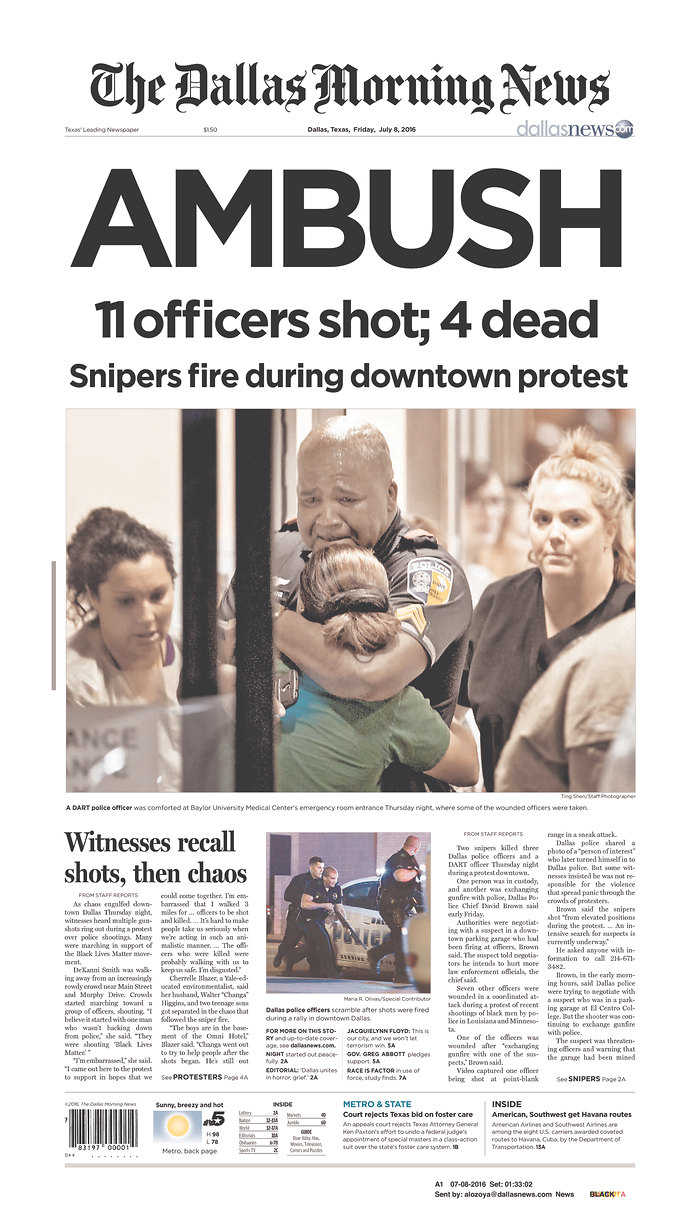G.J. McCarthy thought the protest was wrapping up Thursday night in Dallas.
It had been peaceful. He’d captured great moments on video, including people in passing cars slowing to offer protesters fist bumps.
So when gunfire that would eventually take the lives of five Dallas police officers began, McCarthy, a photojournalist for The Dallas Morning News, thought it was just fireworks.
Then, people started running toward him. The sounds stopped. They began again.
Shots fired at #blacklivesmatter protest @dallasnews @dallasnewsphoto pic.twitter.com/VORP4ailML
— G.J. McCarthy (@gjmccarthy) July 8, 2016
This is a little bit cleaner clip. Shots fired at the #blacklivesmatter protest. pic.twitter.com/DAJVkCll32
— G.J. McCarthy (@gjmccarthy) July 8, 2016
McCarthy and the other photographers and reporters covering the protest were soon joined by more than 30 colleagues, who each had bylines on the Morning News’ initial story.
Coverage of the attack on Dallas police tested several things at the Morning News Thursday night: an aging site, its new replacement, a commitment to experiment on new platforms and the ability to put out a quality print product while simultaneously providing minute-to-minute coverage of the story.
LIVE
When the protest was being planned in Dallas after the police shooting of Alton Sterling in Louisiana, organizers told reporter Hannah Wise to expect about 200 people. After the police shooting of Philando Castile in Minnesota, that number rose to 1,000.
Wise has used Facebook Live a few times before. On Thursday evening, when the first shots were fired, Wise was live again: One minute, she was following people as they walked through downtown Dallas at twilight. Then, there was screaming, running. Someone off camera said, “what is it?” The sirens started.
“OK so everybody watching on Facebook,” Wise told the audience, “I’m really not sure what just happened…I’m gonna stay live as long as I can, unless my editors tell me to get off.”
She stayed on for another 33 minutes, until her phone finally died, then headed back to the newsroom to livestream from there. Through it all, Wise was thinking through the ethical questions of what she was showing. She’d had a talk with one editor before the protest: What should she do if someone starts cussing on camera?
The answer: Live is live.
“I decided to keep recording and broadcasting and add as much context as I could with my voice while keeping myself safe,” Wise said. “I thought it was important to document and important to bear witness to what happened.”
She understands concerns about live streaming. But everyone’s a publisher now, Wise said.
“If this is where people are going to be broadcasting these things anyway, it’s better to be in that space and doing it in a responsible and ethical way.”
Through the night, Wise was careful to talk about what was known, to admit what wasn’t and to point people to the Morning News’ site for confirmed reports.
That site, however, was not ready for all those people.
BETA
Last Wednesday, the Morning News quietly launched a beta version of its new website. They were mostly testing it and getting everyone comfortable with a new content management system. But when the story of the police shooting first broke, it overwhelmed the old site and caused loading problems for some users.
“So our only option was essentially to do a live beta launch and start pushing people into the beta site,” said Robyn Tomlin, managing editor at the Morning News.
It wasn’t ready, and comments and search weren’t yet active, but people could read what was happening, Tomlin said. And it’s a site that’s built for mobile.
“It’s a really tested-under-fire moment.”
The shooting unfolded around the same time that the print paper needed to be in production, as well — another test of agility.
“In a newsroom where we have so intensely focused on digital, having to turn intense attention to doing a great print product on that short of a deadline was sort of an interesting moment,” Tomlin said.
PREPARE
Editors didn’t have time to give anyone advice on how to switch from covering a protest to covering a deadly shooting Thursday night. Instincts kicked in for everyone, Tomlin said.
When she was an intern at The New York Times, Wise watched unfolding coverage of Ferguson and the execution of journalist James Foley. In some ways, that prompted her to always prepare for the worst.
McCarthy spent the night and early morning crouched behind a police car with a father and terrified son, inside a parking garage, outside a hotel, inside a bus station.
He hasn’t yet thought about how he switched modes Thursday night. He just did. There’s really no way to mentally prepare yourself, he said.
“It just sort of happens, and you hope for the best.”








